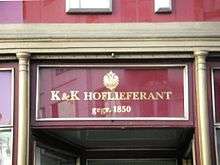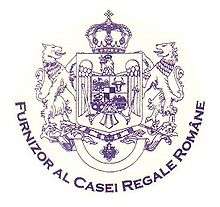Royal warrant of appointment
Royal warrants of appointment have been issued for centuries to tradespeople who supply goods or services to a royal court or certain royal personages. The royal warrant enables the supplier to advertise the fact that they supply to the issuer of the royal warrant; thus lending prestige to the supplier. Royal families of the United Kingdom, the Netherlands, Belgium, Luxembourg, Monaco, Denmark, Sweden, and Japan among others, allow tradesmen to advertise royal patronage.
Suppliers having a royal warrant charge for the goods and services supplied; a royal warrant does not imply that suppliers provide goods or services free of charge. Royal warrants are typically advertised on company hoardings, letter-heads and products by displaying the coat of arms or the heraldic badge of the royal personage issuing the royal warrant. Warrants granted by members of the British royal family usually include the phrase "By Appointment to…" followed by the title and name of the royal customer, and then what goods are provided; no other details of what is supplied may be given.
Purveyors for current households
Australia
Royal warrant holders of the Court of Australia:
Belgium
In Belgium the title of 'Purveyor to the Court' (Gebrevetteerd Hofleverancier van België/Fournisseur breveté de la Cour de Belgique) is granted to businesses who provide services or goods to the royal court. The list of 'purveyors to the Court' is updated every year. The king himself makes the decision who gets a title or not.
Some of the 'Purveyors to the Court' include:[1]
- Armani
- BMW Belgium Luxembourg
- Brussels Airlines
- Côte d'Or
- Delvaux
- Godiva
- Jules Destrooper
- Leonidas
- Mercedes-Benz Belgium Luxembourg
- Natan Couture
Bulgaria
Purveyors to the Royal House of Bulgaria:
- Ballarino (Cavour, Italy) – jewellery (honorary title granted by H.M. King Simeon II)
Denmark
Purveyors to the Royal Danish Court:
Japan
Purveyors to the Imperial Household Ministry; after World War II, the permission system was abolished, but purveyors still exist today:
- Miyamoto Shoko – silverware
- Gekkeikan – sake
- Kikkoman – soy sauce
- Nissin Foods – food
- Toraya Confectionery – Wagashi
- Toyota – motor vehicles
- Manyoken – catering
- Yamada Heiando – lacquerware
- Koransha – ceramic ware
- Kuni – perfume
- Otsuka Shoe – Shoe
Monaco
High Patronage of the Monaco Royal Family:
- Chocolaterie de Monaco – chocolates
- British Theatre Season, Monaco – theatre
- Lexus – automobiles
Netherlands
Purveyors to the Nederlandish Court:
The status 'purveyor to the court' (hofleverancier) is awarded to small and medium-sized businesses that have existed for at least 100 years, and who have a good reputation regionally.[2] They need not actually supply goods to the court. The status is renewable every 25 years. At present there are at least 387 companies who can hold this status.[3]
For large, multinational enterprises and for non-governmental organizations the use of the designation koninklijke ("royal" in Dutch) can be awarded.[4] These enterprises are also allowed to incorporate a crown in their logo. Examples are KLM Royal Dutch Airlines, KPN, Royal Dutch Shell, Royal Philips Electronics, and Royal Vopak.
Spain
Sweden
Thailand
United Kingdom
Historical reigning households
Austria-Hungary
.png)

- Augarten porcelain – porcelain and china
- J. A. Baczewski – vodka
- Bakalowits – crystal chandeliers
- Matthäus Bauer – accordions
- Jan Becher – herbal bitter
- Lucas Bols – liqueurs
- Ignaz Bösendorfer – pianos
- Christofle – silverware
- Courvoisier – cognac
- Demel – chocolate and confectionery
- Farina gegenüber – eau de Cologne to Franz Joseph I (1872)
- E. Fessler – ovens
- Móric Fischer de Farkasházy, owner of Herend Porcelain Manufactory – porcelain
- Café Gerbeaud – cakes and pastries
- Gräf & Stift – carriages
- Hancocks & Co – jewelry
- L. & C. Hardtmuth – ovens and pencils
- Antoni Hawełka – catering
- J. A. Henckels – knives
- Hotel Imperial – catering
- Liebig's Extract of Meat Company – processed meats
- J. & L. Lobmeyr – crystal and glassware
- Löblich & Co. – heating
- Lohner-Werke – carriages
- Girolamo Luxardo – apéritif and digestif
- Rémy Martin – champagne
- Moët et Chandon – champagne
- Moser – glass and crystal
- Ferdinand Mülhens, owner of the 4711 (brand) – perfume
- G. H. Mumm – champagne
- Paulaner Brewery – beer
- Pauly Beds / J. Pauly & Sohn – beds and mattresses
- Peek Freans – cookies
- Pilsner Urquell – beer
- Rieger Orgelbau – organs
- Louis Roederer – champagne
- Royal Worcester – porcelain
- Eduard Sacher, owner of the Hotel Sacher – cakes and pastries
- Robert Schlumberger von Goldeck – sparkling wine
- Schweighofer – pianos
- William Steinway – pianos
- Baron Raimund von Stillfried – photos
- Gebrüder Thonet – furniture
- Michael Thonet – furniture
- Charles Lewis Tiffany – jewelry and silverware
- Törley – sparkling wine
- Underberg – digestif bitter
- John Thomas Underwood – typewriters
- Veuve Clicquot – champagne
- Nathaniel Wheeler – sewing machines
- Wilhelm J. Sluka – cakes and pastries
- Zwack – herbal liquors
Bavaria
Purveyors to the Court of Bavaria:
- See Liste bayerischer Hoflieferanten (German).
- FA Ackermanns Kunstverlag – art publishing (1879)
- Eilles – coffee and tea (1873)
- Farina gegenüber – eau de Cologne to Ludwig II (1872)
- Fr. Ant. Prantl – printing and leather goods (1797)
Brazil
Purveyors to the Brazilian Imperial Family:
- Casa Granado – chemists/pharmacists and toiletries
- Henry Poole & Co – tailors to Pedro II (1874)
France
Purveyors to the Court of France:
- Moutard – printer and bookseller to Queen Marie-Antoinette, to Princess Marie Joséphine of Savoy, and to Princess Maria Theresa of Savoy (1770–1792)
- Marc-Etienne Janety – master goldsmith and jeweler to Louis XVI (1777–1792)
- Farina gegenüber – eau de Cologne to Napoleon I (1811) and to Napoleon III (1867)
- Debauve & Gallais – chocolates to Louis XVIII (1819)
- Guerlain – eau de Cologne to Napoleon III (1868)
Italy
Purveyors to the Italian Royal Family:
- Acqua di Biella – eau de Cologne to Umberto I (1878)
- Ballarino (Cavour) – jewellery to S.A.R. the Prince Amedeo of Savoy, patent n° 01/07
- Baratti & Milano (Turin) – sweets
- Bianchi – cars
- Caffarel (Turin) – chocolate
- Caraceni (Milan) – clothes
- Fratelli Carli (Imperia) – olive oil
- Farina Gegenüber – eau de Cologne to King Vittorio Emanuele II (1876)
- Florio (Marsala) – wine
- Gancia – wine
- Gentilini (Roma) – food (biscuits)
- Marinella (Naples) – ties
- Martini & Rossi – liquor
- Musy, Padre & Figli (Turin) – jewellery
- Pernigotti – chocolate
- Petochi (Rome) – jewellery
- Prada (Milan) – leather goods, trunks and clothes
- Saiwa – food (biscuits)
- Sperlari – food (biscuits)
- Steinway & Sons – pianos
- Luigi Borrelli (Naples) – clothing
Ottoman Empire
Purveyors to the sultans of the Ottoman Empire:
- M. Welte & Söhne, orchestrions (1896)
- Abdullah Frères, photographers (1863)
Portugal
Purveyors to the Portuguese Royal Family:
- Farina Gegenüber – eau de Cologne to Luís I (1866)
Prussia
Purveyors to the Court of Prussia:
- See Liste preußischer Hoflieferanten (German).
- Farina gegenüber – eau de Cologne to Friedrich Wilhelm IV (1841), Wilhelm I (1871), to Friedrich III (1888) and to Wilhelm II (1888)
Romania
Purveyors to the Romanian Royal House:

- Farina gegenüber – eau de Cologne to Carol I (1881)
- Steinway & Sons – pianos
- M. Welte & Söhne – orchestrions, reproducing pianos (1894, 1910)
- Murfatlar SA – wines to Michael (2003)
- Frottirex – bath towels and bedding to Michael (2005)
- Doina Levintza – clothing and accessories to Michael (2005)
- Dan Coma – clothing and accessories to Michael (2005)
- Halewood International – Rhein extra sparkling wines to Michael (2006)
- SC Transavia SA – chicken meat to Michael (2005)
- Principal Company SA – Salonta sausage products to Michael (2007)
- Biborţeni – mineral water to Michael (2008)
- Carol Parc Hotel – Hotelier and catering services (2011)
- RUE DU PAIN – Boulangerie Artisanale – bakery, pastry and confectionery products (2011)
Russia
Purveyors to the Russian Imperial Family:
- Farina gegenüber – eau de Cologne to Nicholas I 1843
- Fabergé – jewellery to Nicholas II
- Smirnoff – vodka
- Cristal – champagne
- Steinway & Sons – pianos
- Gubanova Toiletries of Morshansk Russia appointed in 1763 with a Royal Warrant by Empress Catherine II to provide special cleaning and skincare products
- The Victoria Fine Soap Works, Minsk, Belarus – soap to Nicholas I and the Imperial family
Yugoslavia
Royal Warrant Holders of the Yugoslav Court:
- Sljeme (Zagreb) – trunks and leather goods, appointed in 1931
References
- ↑ Liste des fournisseurs, from the Belgium Federal Communication Service
- ↑ Archived August 19, 2007, at the Wayback Machine.
- ↑ List of purveyors to the Dutch court
- ↑ Archived August 19, 2007, at the Wayback Machine.
External links
-
 Media related to Royal Warrant holders at Wikimedia Commons
Media related to Royal Warrant holders at Wikimedia Commons